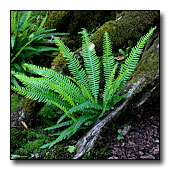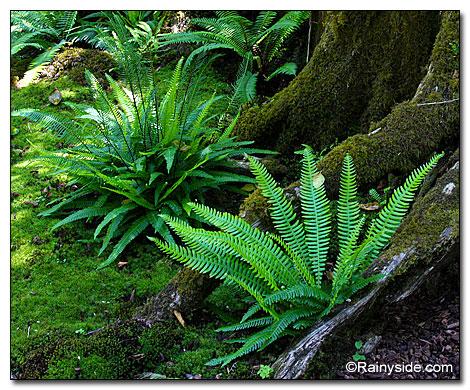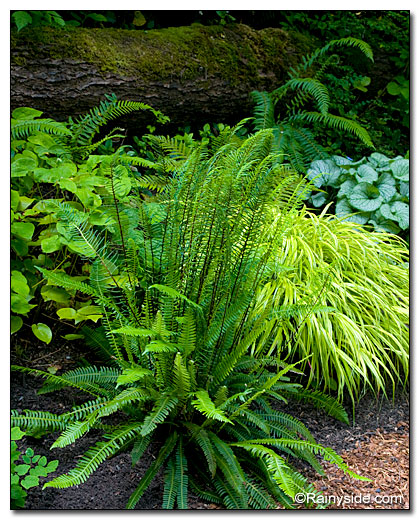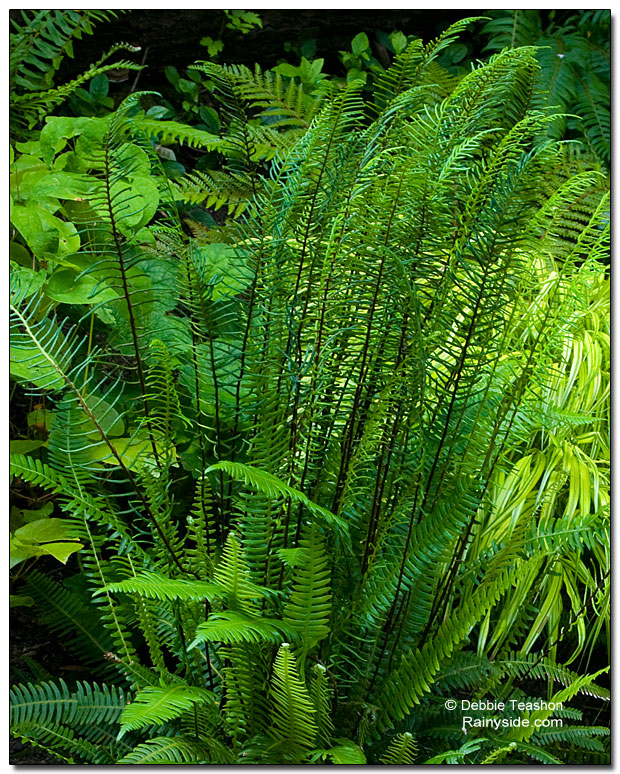Blechnum spicant
DEER FERN, LADDER FERN, HARD FERN
Family: Blechinaceae
Pronounced: BLEK-num SPEE-kant

Quick Jumps
Growing Guide
Rainy Side Notes
GROWING GUIDE

Origin:
North America: Alaska, British Columbia, California, Idaho, Oregon, Washington, Europe, and N.E. Asia.
Plant Group:
Ferns.
Hardiness:
Sunset zones: 2b-7, 14-19, 24.
USDA zones: 5-8.
Heat zones: 8-5.
Mature size:
Height: 8-20 inches (20-50 cm).
Width: 3 feet (60 cm).
Leaf attributes:
Lance-shaped and pinnate, dark green, evergreen fronds.
Growth habit:
Compact growth habit, creeping rhizomes.
Light:
Partial to deep shade.
Soil:
Humus rich (preferably with leaf mold), moist, acidic soil.
Feeding:
None needed.
Propagation Methods:
Divide in spring.
Sow spores in late summer.
Rainy Side Notes

Deer ferns are native to different areas around the globe. They are easily identifiable when its ladder-like, fertile, deciduous fronds, which grow stiffly upright in the center, are present. The outer, sterile evergreen fronds spread out in a rosette around the perimeter.
The Greek word for this hardy fern is Blechnum, while spicant means a tufted hard fern; in other words, it's a hardy, hard fern. Deer ferns thrive in a variety of environments, from sea to alpine altitudes, but they truly shine in a mossy woodland setting. This is a place with plenty of moisture, acidic soil, and a canopy of trees that provide dappled sunlight. In such a setting, the new growth of deer ferns is a pale green, standing out against the mature deep green foliage.
Deer ferns are a versatile addition to maritime gardens in the Pacific Northwest, thriving in acidic soil and shade. Surprisingly, they can even handle full sun if given extra supplemental watering. This means that in full sun, deer ferns will need more frequent and thorough watering to maintain their moisture levels. In my garden, they grow under native vine maplesmdash;Acer circinatum. However, the fern also thrives on neglect under my Chinese redbud tree—Cercis chinensis 'Avondale' and beneath an arbor.
One of the most stunning displays of deer ferns can be found at the Bloedel Reserve on Bainbridge Island in Washington State. This estate is home to an enormous moss garden, where these fern beauties thrive. The garden, meticulously maintained, is a sight to behold, with not a piece of moss out of place. If you haven't visited this estate, filled with beautiful gardens, you are in for a treat and a wealth of inspiration for your own landscape.
Wildlife
Deer and mountain goats graze on these ferns; after the deer's antlers break off, they rub the sore stubs on the fronds.
Ethnobotany
Deer ferns have a rich history of use by native Americans. They observed animals, such as deer and mountain goats, rubbing their sore stubs on the fronds and began to use them for their skin sores. They also chewed the foliage for internal cancer treatments, digestive aid, and diarrhea. A poultice made from the fronds was applied to areas of the body afflicted with paralysis and other ailments. The connection between humans and deer ferns adds to their significance.
When no other food was available, two tribes used the ferns as starvation food, eating it only as a last resort. Others placed the fronds under food in their steaming pits. Other uses included frond fiber for bedding, rugs, and mats.

Fertile fronds
Top image photographed at Bloedel Reserve; bottom image photographed in the Treherne and Michel garden. Both gardens located on Bainbridge Island, Washington.
A Pacific Northwest Plant of the Week (2012)

Gardening for the Homebrewer: Grow and Process Plants for Making Beer, Wine, Gruit, Cider, Perry, and More
By co-authors Debbie Teashon (Rainy Side Gardeners) and Wendy Tweton
Copyright Notice | Home | Search | Natives

